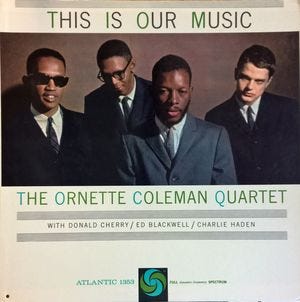Some Jazz Records: (Early) Ornette Coleman Clippings
Comments on recordings from musicians and other actors of the jazz scene. Random and not-so-random listening cues from the archives.
Ornette Coleman, Change of the Century, Atlantic (SD) 1327, 1960, LP.
Ornette Coleman’s star rose amid much critical brouhaha after his late 1959 debut on the New York stage. Right before it all unfolded, Coleman recorded what would later become his second album for Atlantic, Change of the Century. "Every member of the group made an important and distinctly personal contribution to this album, which I think is the best we have made so far," the leader said in the liner notes. "If you listen with preconceived ideas, you might miss a lot that’s in it," Coleman added in the columns of Metronome. "But if you listen to it as natural music, the thing flows without you having to use your mentality to appreciate it. You hear the pure emotion. That’s what I try to get across in my playing. The natural emotions."
Ornette Coleman Quartet, This Is Our Music, Atlantic (SD) 1353, 1961, LP.
"We did thirty tunes in three weeks. All originals. Everything I’ve ever recorded has been a piece of my own," Ornette Coleman says in The Jazz Life. "Until I heard these last tapes, I hadn’t realized all the different approaches we’d been developing in the past few months. I think the new albums will give the public and the musicians a more accurate idea of what we’re trying to do. In some of them, we put what would usually be regarded as the theme in the middle; and at the end, each man finishes by improvising alone without returning to the theme." The sessions Coleman was talking about took place for three consecutive Tuesdays in the summer of 1960, at Atlantic Recording Studios in New York. Out of the multiple albums projected, only one was immediately released, This Is Our Music, which used selections from all three sessions.
Miles Davis, Miles Davis in Europe: Recorded Live at the Antibes Jazz Festival, Columbia CL 2183 (CS 8983), 1964, LP.
The cover of the July 1965 issue of Liberator magazine — "the voice of the African-American" — featured a picture of Ornette Coleman playing his famous plastic saxophone. Inside was one of the most noteworthy articles to appear since Coleman’s return to public performance after a two-year hiatus. "There is no jazz musician on the scene today who moves me," Coleman told Charlie L. Russell. "But, I will say this, that record that Miles Davis made in Europe is the most honest record I’ve heard in jazz in over ten years… But there is a standard evolving in jazz which says 'play yourself.' […] Jazz musicians should be creating their own music rather than playing pop tunes, the very music that keeps them from making it." In all likelihood, Coleman was referring to Miles Davis in Europe, one of the first albums to document the important new band put together by the trumpeter in 1963, with George Coleman, Herbie Hancock, Ron Carter, and Tony Williams (who had previously been working with Jackie McLean).
Joan Sutherland, Operatic Arias, Decca LXT.5531, 1959, LP.
Ornette Coleman made his first appearances in Europe in 1965. Asked by the British Melody Maker about the musicians he listened to, Coleman answered: "If I listen to records it is just for the emotional experience. I like mostly to listen to Joan Sutherland. I’d like to get her to make a record with me. I can’t think of anyone else." An Australian soprano, Joan Sutherland had her breakthrough on record (arbitrarily picked for this selection) at roughly the same time as Coleman. One of the 20th century’s major opera stars, Sutherland remained a long-lasting interest for the saxophonist, as his son Denardo mentioned in an essay in his memory.







